Students Catch a Star: researching and observing a solar eclipse Teach article
Students Jan Měšťan and Jan Kotek and teacher Marek Tyle from the Gymnázium Písek in the Czech Republic won the 2007 Catch a Star competition. Sai Pathmanathan describes their prize-winning project.
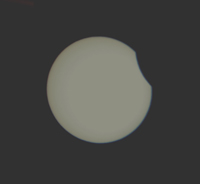
Image courtesy of Marek Tyle,
Jan Měšťan and Jan Kotek
Jan Měšťan has been interested in astronomy for several years. When he heard about the international astronomy competition, Catch a Starw1, he asked his school friend Jan Kotek to take part too. With the help of their physics and information technology teacher, Marek Tyle, the two Czech 15-year-olds not only entered the competition, but won first prize. The competition is run by the European Organisation for Astronomical Research in the Southern Hemisphere (ESO)w2 and the European Association for Astronomy Educationw3. Their prize was a week-long visit to the La Silla Paranal observatory in Chile, operated by ESO.
Their project involved researching and observing the solar eclipse that occurred on 29 March 2006. The total eclipse was only observable in Libya, Turkey and Russia but from their school in the Czech Republic, the teenagers hoped to observe a partial eclipse. The project was not simply a chance for two enthusiastic students to enter a competition, it was an inspiration for the whole school. Jan and Jan gave a presentation to other students at their school, the Gymnázium Písek, after which the whole school observed the eclipse. Moreover, as part of the project, they hoped to carry out some scientific experiments during the eclipse.
Solar eclipses
Jan and Jan were interested in why solar eclipses occur, how to predict their occurrence, the characteristics of solar eclipses, and when they occurred in history. They investigated why solar eclipses are important to modern scientists, what observational methods astronomers use and how to use equipment to collect meaningful data.
A solar eclipse occurs when the Sun, the Moon and Earth are in a straight line (which can only happen during a new moon), so that the Moon casts a shadow on the Earth. Because the Moon and the Sun appear approximately the same size at this time (the Moon is approximately 400 times nearer to Earth than the Sun and has a diameter approximately 400 times smaller), the Moon can cover up (‘occult’) the Sun, when viewed from Earth.
A similar situation occurs during the more frequent lunar eclipse, when the Moon and Earth swap positions, so that Earth casts its shadow on the Moon. Eclipses also occur elsewhere in the Universe: total solar eclipses can be observed on Jupiter when its moon, Io, casts a shadow on it, or when Saturn’s moon, Titan, comes between it and the Sun. Planetary transits (when a planet can be seen to cross the Sun) may also be observed from Earth, with the Venus transit being perhaps the most important as it was used historically to measure the distance between Earth and the Sun.
Jan and Jan were fascinated by documented appearances of the solar eclipse throughout history; their findings formed part of their project and presentation to the rest of the school. The first written record of a solar eclipse is from 2137 BC, when two Chinese court astronomers were executed because they forgot to alert the emperor to the forthcoming total solar eclipse. At the time, Chinese people believed that a dragon was coming to eat the Sun.
During their research, Jan and Jan became increasingly aware of the scientific significance of the phenomenon. During a solar eclipse, astronomers can observe properties of the Sun that are normally invisible, such as the corona or the solar chromosphere (a thin, coloured layer of the Sun’s atmosphere), from which they can learn about the structure and composition of the Sun. By looking at the shape of the Moon as it crosses the Sun, they can draw conclusions about the structure of the lunar surface. Furthermore, the decreased levels of sunlight during an eclipse allow astronomers to observe stars, asteroids and comets and the other objects that are very close to the solar disc and cannot normally be seen. The low light levels also affect living organisms: many flowers close their petals and animals may go to sleep. Not only astronomers, therefore, but also botanists, ethologists and psychologists are interested in the effects of solar eclipses.
The presentation
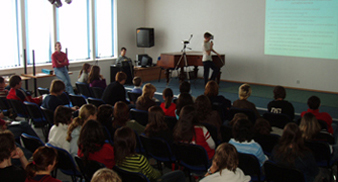
Image courtesy of Marek Tyle,
Jan M?š?an and Jan Kotek
The main aim of their project was to show the partial solar eclipse to students of Gymnázium Písek and to share what they had learned during their research. So that everyone would be well informed on the day, Jan and Jan delivered a presentation to their fellow students 15 days before the eclipse. Their presentation included:
- General information about the solar eclipse (origin, types, significance for humans)
- Information about the total solar eclipse on 29 March (such as its path of totality and maximum duration)
- Details of the planned observation of the partial solar eclipse at Gymnázium Písek (observation devices, observation safety)
- A description of the scientific experiments to be conducted during the observation (measuring the decrease in brightness and temperature)
- How to make a filter to observe the eclipse
- Organising students so that they could all take part in the observation (644 students and teachers all wanted to watch).
At the end of the presentation, everybody received an information leaflet about the planned observation to pass on to other interested people. Three school noticeboards were also dedicated to information about the eclipse.
The observation
The last solar eclipse seen in the Czech Republic was on 3 October 2005, although clouds made it difficult to observe. Jan and Jan were hopeful, however, that the solar eclipse on 29 March 2006 would be more visible and that they could gather some useful data.
Jan and Jan chose a suitable terrace from which observations could be made. They and other students at Gymnázium Písek planned to use a variety of observation devices, including solar filters (made from X-ray films), binoculars with solar filters for safe observation of the Sun, telescopes, cameras and devices to measure light levels and temperatures.
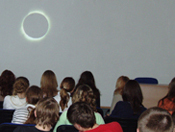
total solar eclipse in the
assembly hall
Image courtesy of Marek Tyle,
Jan Měšťan and Jan Kotek
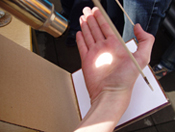
eclipse on the palm
Image courtesy of Marek Tyle,
Jan Měšťan and Jan Kotek
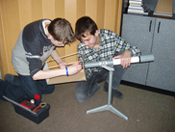
he apparatus
Image courtesy of Marek Tyle,
Jan Měšťan and Jan Kotek
The day of the eclipse dawned cloudy and the students were anxious that they would not be able to see anything. But by 9.15 in the morning, the sky had cleared up and the observation went ahead as planned. From 9.40, classes began to visit the observation platform. The live broadcast of the total solar eclipse viewed from Turkey was shown on a television screen in the assembly hall for everyone to see.
The air temperature was around 11°C and there was a strong wind outside; sometimes the Sun hid itself behind clouds. Because of this unpredictable weather, Jan and Jan could not carry out their planned scientific experiments (measuring the decline in brightness and temperature). However, it did mean that they could spend more time helping fellow students to use their observation devices and telling them more about what they had learned about solar eclipses during their project. Even though they were disappointed by the weather, Jan and Jan learned (and taught) a lot about solar eclipses and hope that everyone enjoyed the experience as much as they did.
Report from Paranal
Just before Science in School went to press, the prize winners sent this report.
Paranal, Chile, is a really amazing place: it is in the Atacama desert, believed to be the driest place on Earth, and has the best astronomical technology in the world.
We visited the platform of ESO’s Very Large Telescope (VLT) for the first time on 12 August. From the platform, there is a wonderful view of the Andes and the Pacific – especially beautiful at sunset. Until the third day of our visit, the sky was very cloudy, but then, at about midnight, the sky cleared and we watched the telescope domes opening. First, we visited the dome of the telescope Yepun, one of the four main telescopes of the VLT.
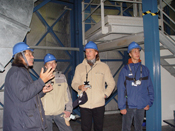
telescope works. From left:
Stan Stefl, Jan Měšťan,
Marek Tyle and Jan Kotek
Image courtesy of Marek Tyle,
Jan Měšťan and Jan Kotek

summit, with the sun setting
over the cloud-covered Pacific
Ocean
Image courtesy of ESO
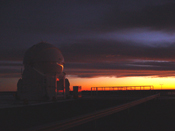
Image courtesy of Marek Tyle,
Jan Měšťan and Jan Kotek
Next, we visited the control centre and met Stan Stefl, a Czech astronomer working at Paranal. We asked him about his work at ESO and the instruments at Paranal and he explained how the VLT interferometer works: it combines the light from the individual telescopes into a giant virtual telescope. This helped us to understand the work of the astronomers at Paranal. After our visit to the control centre, we took some pictures of the southern sky and saw the Magellanic Clouds (see image) and the Southern Cross. We would like to thank Laura Ventura, public relations manager of the Paranal observatory, who showed us other objects in the sky and helped us with our stay in Chile.
We also investigated other features of Paranal: we went walking in the area surrounding the observatory, visited the gym and enjoyed delicious meals in the very cosy dining room. Paranal made a great impression on us: it is a very good facility for astronomers and scientists from all over the world. In addition to Paranal, we visited the ESO headquarters in Santiago and Antofagasta and made a day trip to the city of Valparaíso.
We will inform our schoolmates about our trip and use the knowledge that we gained in future physics lessons.
Marek Tyle, Jan Měšťan and Jan Kotek
Acknowledgements
Jan Měšťan and Jan Kotek would like to thank the management and the director of their school, Mr Petr Pícha, for allowing the observation to take place; their teacher Mr Jakub Cenek, who helped with the translation of the project; a professor in the Department of Physics at the University of South Bohemia in ?eské Bud?jovice, Mgr Petr Jelínek, who acted as a consultant during this project; Pavel Vajík, who allowed them to borrow his Proximus 100 reflector; and the weather, for not being too cruel during the observation.
Web References
- w1 – Full details of the project are available on the Catch a Star website: www.eso.org/catchastar/cas2007/
- w2 – To learn about ESO’s work and to view (and use) ESO’s stunning astronomical images, see www.eso.org
- w3 – The European Association for Astronomy Education works to improve and promote astronomical education at all levels in all European institutions involved in teaching astronomy: www.eaae-astro.org
- w4 – For more details about the Very Large Telescope and the Paranal Observatory, see:
- Pierce-Price D (2006) Running one of the world’s largest telescopes. Science in School 1: 56-60.
Institutions
Review
This article is an interesting story about the development of an astronomy project by school students: the two teenagers succeeded in preparing presentations, experiments and an observation session in their school for other pupils, taking advantage of a partial solar eclipse. This could encourage teachers to consider how a local scientifically interesting event can be used to trigger a bonanza of social, cultural, educational and experimental events.
Problems with the weather during the eclipse are a rather common occurrence for experimental astronomers; the students, therefore, could fully experience a real astronomer’s disappointment, which can be a daily companion to experimental scientists.
The report is suitable mainly for teachers of physics and astronomy and is presented in plain and simple language.
Marco Nicolini, Italy





